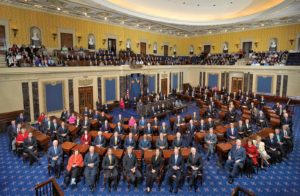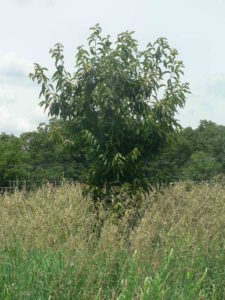Congress is now considering funding for various agencies and programs for Fiscal Year 2018 – which begins on October 1, 2017. Both the House and Senate Appropriations committees have adopted bills to fund APHIS (in the agriculture appropriations bill) and USFS (in the interior appropriations bill). Once these are passed – I expect with little change – by the appropriate chambers, the two very different bills will be reconciled by a Conference Committee made up of members of both the House and Senate and then passed in final form.
Please thank the Senators on the Agriculture Appropriations Subcommittee for their strong support for APHIS’ programs targeting tree pests. Ask them to maintain this support during the Conference – where the House members will be pushing for cuts.
To read the bills and accompanying reports, go here for the House appropriations bill for USDA, (including APHIS); here for the House Interior bill (including the USFS). Go here for the Senate appropriation bill for USDA. (Links to the bills and reports are at the end of each press release.) The Senate Appropriations Committee has not yet acted on the Interior bill.
Animal and Plant Health Inspection Service
Appropriators are working under severe pressure given the large spending reductions proposed by the President in the Administration’s budget sent to the Congress earlier in the Spring.
The House appropriated $906 million for APHIS. This is $40 million less than in FY17 but $96.4 million more for APHIS than the Administration requested. The House agriculture appropriations bill made significant cuts in the Tree and Wood Pests program in order to stay within its overall total while maintaining or expanding other programs. The result would devastate the Tree and Wood Pests program. The House bill cuts funding for this program by 30% from the level provided in recent years – from $54 million to $38 million.
The Senate bill, in contrast, increases funding for the Tree and Wood Pests program by $2 million – from $54 million to $56 million. The Senate was able to do this because its bill provided significantly more money for APHIS than did the House: the Senate bill appropriated $953.2 million for APHIS, $7 million above the FY17 funding level; $143.2 million above the Administration’s budget request; and $47 million above the House funding level.
I have blogged often about the necessity of maintaining the Tree and Wood Pest program. In recent years, APHIS’ Asian longhorned beetle (ALB) eradication program has cost $35 – $40 million per year. The program has succeeded in shrinking the New York infestation by 85% and the Massachusetts infestation by 34%. The Ohio infestation has also been reduced – although by considerably less. In its FY2016 annual report, APHIS said the infestation area had been cut by 15%. However, earlier in July APHIS announced that the Ohio infestation is larger than previously known. The quarantine zone was expanded from 61 to 62 square miles. Now is not the time to abandon the 21-year old ALB eradication effort. For a reminder of the threat this insect poses to our hardwood trees, see the write-up here.
The report from the Senate Committee link says that it is “essential” to complete eradication of the ALB.
APHIS and the states have already agreed to cut back the agency’s efforts to regulate movement of ash wood in order to slow the spread of the emerald ash borer (EAB). I am unhappy about this retreat. Still, APHIS planned to continue to survey for EAB in unregulated areas, to educate appropriate publics, to coordinate with affected states, and to produce and disperse biocontrol agents. The Senate funding level – unlike the House funding level – would allow APHIS to maintain these vitally important activities aimed at protecting America’s urban and wildland forests from EAB (For a reminder of that threat, see the write-up here).
Finally, states and stakeholders will expect APHIS to continue its program to slow the spread of the gypsy moth – a program which has received from the Tree and Wood Pest program $5 – $6 million per year in recent years. APHIS must also be prepared to eradicate any newly detected outbreaks, especially of the Asian gypsy moth on the West coast.
I have repeatedly argued that APHIS should expand its program so as to address the many additional tree-killing pests introduced in recent years, including
- Redbay ambrosia beetle / laurel wilt disease
- Sirex woodwasp
- Goldspotted oak borer
- Walnut twig beetle and thousand cankers disease
- Soapberry borer
- Polyphagous & Kuroshio shot hole borers
- Velvet longhorned beetle
- Spotted lanternfly
Therefore, I rejoice to see that the Senate report link says: “The Secretary is directed to report to the Committee regarding the steps being taken to eradicate the Asian long-horned beetle and spotted lanternfly and to minimize the spread of other pests such as the polyphagous and Kuroshio shot hole borers (emphasis added).
The Senate report also calls on APHIS to continue efforts to control the coconut rhinoceros beetle in Hawai`i and Ceratocystis disease That latter is presumably the pathogen causing rapid `ohi`a death in Hawai`i.
The other APHIS program which has supported programs targetting tree-killing pests is the Specialty Crops program. The House bill increased funding for the Specialty Crops program from $156 million to $160 million for FY18. However, $152.3 million of this total – 95% — is allocated to specified agricultural pests, including fruit flies, diseases of citrus trees, glassy winged sharpshooter and European grape vine moth, pale cyst nematode, and light brown apple moth. This means that little is left for addressing sudden oak death or tree-killing pests next year.
Strangely, APHIS said, in its FY16 Annual Report, that the European grape vine moth had been eradicated. So why does the FY18 House appropriations bill allocate $5 million for this pest? It might be for continued surveillance to verify that eradication has been successful.
The Senate bill provides even more – $166 million – for the Specialty Crops program. The Senate Committee report instructs APHIS to spend “no less than the fiscal year 2017 level of funding” to manage potential movement of sudden oak death in the nursery trade – without specifying the amount.
The House committee did expand overall funding for plant pests to a total of $294 million. The House report says that this total includes an increase of $12.5 million for a Plant Pest and Disease Management and Disaster Prevention Program. This funding explicitly can be spent on tree and wood pest surveillance as well as the clean plant network and citrus health. This increase is welcome, but it does not make up for the 30% cut in specific funding for the tree and wood pest program. The increased surveillance is of doubtful value if it does not result in eradication or containment efforts!
Again, the Senate bill is more generous; it provides $320,308,000 for plant health.
The decisions made by the House Appropriations Committee clearly show the importance of lobbying by traditional agricultural interests in defending funding for programs of interest to them. Several programs targetting diseases of livestock and poultry were maintained at the FY17 funding level. As noted above, the “specialty crop pests” account was increased.
Those of us who care about protecting our trees must become more visible advocates for these programs.
As in the past, both the House and Senate reports support APHIS’ access to emergency funding to be obtained as transfers from the Commodity Credit Corporation for the “arrest” and eradication of animal and plant pests and diseases that threaten American agriculture. The House language appears to be less restrictive.
Unfortunately, it has been years since APHIS sought – much less received – funding through the emergency provision to address tree-killing pests. This is why CISP and others are proposing to amend the Farm Bill to broaden APHIS’ authority to access these funds when appropriated funds are insufficient to counter tree-killing pests. (See my blog from early July for information about these proposed amendments and how you can support them.)
The House also follows the Administration in calling for greater cost-sharing with States and other cooperators. The Houe report states: “The Committee directs APHIS to maximize the use of cost-sharing agreements or matching requirements with states, territories, producers, foreign governments, non-governmental organizations, and any other recipient of services in order to reduce the cost burden on the agency.”
The President’s budget request called for even more severe cuts and justified these cuts by saying that the programs could be maintained if the states, localities, and industries benefitting from eradication or containment of the ALB and EAB helped pay for the containment program. The budget called for beneficiaries to pay 50% of program costs. However, states, localities, and industries are very unlikely to make up such severe cuts in funding. Already, local governments across the country are spending more than $3 billion each year to remove trees on city property killed by non-native pests. Homeowners are spending $1 billion to remove and replace trees on their properties and are absorbing an additional $1.5 billion in reduced property values and reducing the quality of their neighborhoods (Aukema et al. 2011; full reference at end of blog.)
Remember: thank your senators for their generosity to APHIS’ tree pest programs – especially if they are members of the Senate Agriculture Appropriations subcommittee (members listed below).
John Hoeven, North Dakota
Thad Cochran, Mississippi
Mitch McConnell, Kentucky
Susan Collins, Maine
Roy Blunt, Missouri
Jerry Moran, Kansas,
Marco Rubio, Florida
Jeff Merkley, Oregon
Diane Feinstein, California
Jon Tester, Montana
Tom Udall, New Mexico
Patrick Leahy, Vermont
Tammy Baldwin, Illinois
US Forest Service
The House Interior Committee provided $92,084,000 for Forest Health Management, $2,416,000 below the FY17 funding level but $1,694,000 above the budget request. The Report does not specify the amounts for federal v. non-federal lands, but the Administration’s request specified $54 million for federal lands and $36 million for cooperative programs managing forests on non-federal lands. (As recently as FY2014, the forest health program received more than $100 million per year.)
The House Interior Committee recommends $278,368,000 for Forest and Rangeland Research, $10,146,000 below the FY 2017 funding level and $19,368,000 above the budget request. $75 million of this total is allocated to the Forest Inventory and Analysis program. The Report says that the Committee does not accept the proposed reduction for invasive species research. This is gratifying. However, I have been unable to find the proposed reduction, and there has never been a “line” specifically for invasive species research. Therefore, I am unclear about what level of funding has been retained. (In past years, the total allocated to research on non-native tree-killing pests averaged about $5 million.)
The Senate Appropriations Committee has not yet acted on the Interior Appropriations bill so I cannot tell you how much money that body will provide for these programs.
SOURCE
Aukema, J.E., B. Leung, K. Kovacs, C. Chivers, K. O. Britton, J. Englin, S.J. Frankel, R. G. Haight, T. P. Holmes, A. Liebhold, D.G. McCullough, B. Von Holle.. 2011. Economic Impacts of Non-Native Forest Insects in the Continental United States PLoS One September 2011 (Volume 6 Issue 9)
We welcome comments that supplement or correct factual information, suggest new approaches, or promote thoughtful consideration. We post comments that disagree with us — but not those we judge to be not civil or inflammatory.
Posted by Faith Campbell


 USDA; photo by F.T. Campbell
USDA; photo by F.T. Campbell
 Customs inspecting wood packaging
Customs inspecting wood packaging